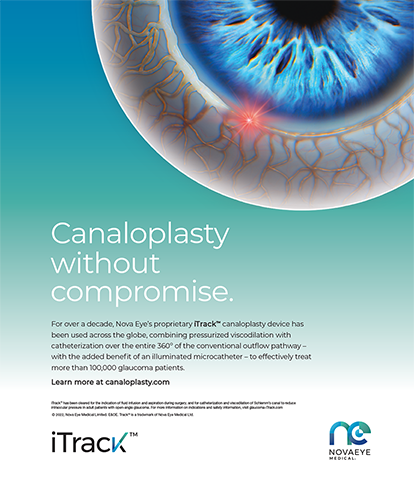I once heard an interesting story from a woman in the ophthalmic industry about the power of online marketing. She was on an airplane sitting next to a male millennial who was a perfect candidate for LASIK—he had disposable income and was interested in the procedure. She told him, “I know the best LASIK surgeons in the country. I know who has the best outcomes, technology, and staff.” She recommended a physician where the man lived, and he was thankful. When the plane landed, the man turned on his phone, went to that surgeon’s website, took one look, and said, “I’m not going to this guy!”
The moral of the story is that no matter where you went to school, how long you’ve been practicing, or how good your outcomes are, your online presence is a deciding factor for many patients. As you develop a marketing plan, you have to approach it from that perspective: what patients want, and not what you think is important. You need to capture the attention of prospective patients with your digital strategy.

Build Your Brand Online
I have been personally involved in marketing eye care practices for about 30 years and specifically involved with digital marketing for 20 years. During those 2 decades, I have watched consumers move away from traditional forms of advertising and promotion. Today, they rely more on the internet—websites, reviews, social media, and Google—to choose a surgeon and the procedure they wish to have performed.
Patients associate your online presence with the quality of your services. They may consider your rankings on Google, the quality of your website, patient reviews, and social media presence. For example, if you do not engage with your target market on social media platforms, prospective patients may think there is something wrong with you. All of these elements affect the quality of your brand, no matter if yours is an established practice or a new practice that you are trying to grow quickly.
Keep in mind that, even if word-of-mouth referrals attract a lot of patients to your practice, they will still visit your website. They will likely also see the websites of a few of your competitors. They may be inclined to visit your practice based on word-of-mouth referral, but a well-designed, functioning website helps get them through your door.

Make It Functional
Textbooks have been written on how to develop an effective website. For the purposes of this article, I will simply touch on some necessary elements. First, your website must be mobile-friendly, with contact information easily viewable and the entire site easy to navigate from a smartphone. This is something that you can check yourself. Pull up your practice’s website on your phone right now and honestly assess how easy it is to find and access information.
Beyond mobile optimization, your website should have unique content such as descriptions of procedures and patient testimonials. The key word here is unique. Copying text about a certain ocular condition or surgical procedure can negatively affect your practice’s ranking on Google and make it more difficult for prospective patients to find you.
Interesting graphics and images on your website also can help attract patients. Think about what patients might want to see. Many of them probably will not be interested in detailed images of the surgical procedure or laser systems you use. Prospective patients are looking for a lifestyle change, so show them what their lives could be like if they get LASIK, cataract surgery, or another procedure.
Maybe your practice just spent $500,000 on a laser, and you want to show it off on your website. Your colleagues might appreciate that, but your patients might not. Think about it: restaurants do not put pictures of their ovens on their websites. Instead, they show pictures of people having a good time with great food.

Socialize
Many eye care practices use social media as another promotional tool. They run a special deal or highlight LASIK or another procedure. In my experience, “Learn more about LASIK” and similar promotional messages turn people off. If you are at a party and the host is constantly trying to sell you something, you will probably get annoyed. Social media work the same way.
A big aspect of your practice’s marketing plan should be the patient experience. What do patients expect, and can your practice meet those expectations? If you promote cutting-edge technology and excellent outcomes online, your staff should emphasize these points when interacting with patients. If you promote that your practice has a world-renowned doctor, you need to repeat that when patients come in.

Setting a Budget
Once you establish the marketing goals for your practice, the next step is to set a realistic budget. Not all marketing efforts achieve the same result, so not all marketing costs are the same. If you hire a third-party marketing expert, make sure that he or she knows the ins and outs of eye care. This person (or people) should understand the terminology that is relevant for your practice. Consumers generally do not know what these words mean, so your marketing messages should discuss them in a consumer-friendly way.
It is hard to provide an estimate of a good marketing budget without knowing your practice and its goals, but I would suggest that $7,000 to $12,000 is a reasonable cost for a new website. A monthly social media budget could range from $300 to $2,000, depending on how much is managed in-house and how many paid campaigns you initiate. If a doctor in your practice is producing and sharing photographs and videos on his or her own, you may not need to invest as much by paying a third party to manage it.
In terms of an online pay-per-click campaign, plan for a minimum of $2,500 to $3,000 per month, or you will not have any leverage in the market. If that figure seems too high for an initial investment, you can try different daily budgets to see where you achieve the highest return. Then, base your monthly budget on that amount.
You must also plan for search engine optimization (SEO). Consumers associate Google rankings with the quality of your care and outcomes. Depending on the size of the market and the scope of your services, expect to invest $800 to $2,000 per month for excellent SEO services.
Finally, automated review management platforms are necessary. Expect to pay between $200 to $300 per month per doctor and location. Don’t expect one review service for one doctor to cover your needs for multiple doctors and locations.
You must remember that you are whatever appears online. It’s not fair, but it is the way of the online world today. Google does not rank surgeons, it ranks websites. Your online presence includes the quality of your mobile-friendly website, your content, your social media engagement, your rankings, your reviews, and other factors. Consumers use these same touchpoints to make their purchasing decisions.





